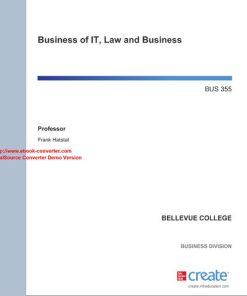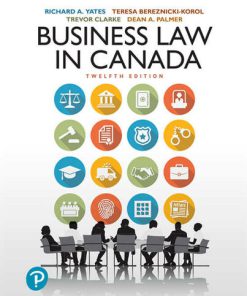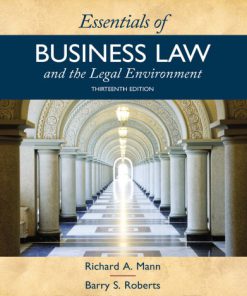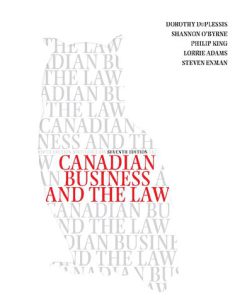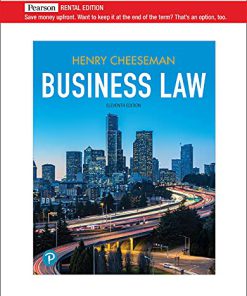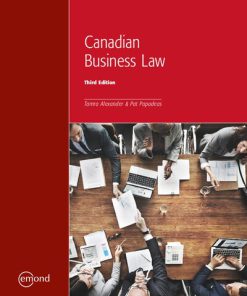Business Law and the Regulation of Business 12th Edition by Richard Mann ISBN 1305509552 9781305663848
$50.00 Original price was: $50.00.$25.00Current price is: $25.00.
Business Law and the Regulation of Business 12th Edition by Richard Mann – Ebook PDF Instant Download/Delivery: 1305509552, 9781305663848
Full download Business Law and the Regulation of Business 12th Edition after payment

Product details:
ISBN 10: 1305509552
ISBN 13: 9781305663848
Author: Richard Mann
Recognized for accurate, relevant, and straightforward coverage, BUSINESS LAW AND THE REGULATION OF BUSINESS, 12E illustrates how legal concepts apply to today’s common business situations. The book’s comprehensive, yet succinct, approach provides the depth of coverage ideal for business success and CPA exam preparation without technical jargon. The text includes both landmark and recent cases with the facts and decision summarized for clarity, while the opinion is carefully edited to preserve the language of the court. More than 220 classroom-tested figures, tables, diagrams, concept reviews, and chapter summaries clarify concepts. To enhance readability, legal terms are clearly defined, explained, and illustrated. In addition, each chapter is carefully organized and enriched by illustrative hypothetical and case examples that relate the material to real-life experiences. Numerous critical-thinking features further challenge and strengthen your analytical skills.
Business Law and the Regulation of Business 12th Table of contents:
Part I. Introduction to Law and Ethics
Chapter 1. Introduction to Law
1-1. Nature of Law
1-1a. Definition of Law
1-1b. Functions of Law
1-1c. Law and Morals
1-1d. Law and Justice
1-2. Classification of Law
1-2a. Substantive and Procedural Law
1-2b. Public and Private Law
1-2c. Civil and Criminal Law
1-3. Sources of Law
1-3a. Constitutional Law
1-3b. Judicial Law
1-3c. Legislative Law
1-3d. Administrative Law
1-4. Legal Analysis
Chapter Summary
Chapter 2. Business Ethics
2-1. Law Versus Ethics
2-2. Ethical Theories
2-2a. Ethical Fundamentalism
2-2b. Ethical Relativism
2-2c. Utilitarianism
2-2d. Deontology
2-2e. Social Ethics Theories
2-2f. Other Theories
2-3. Ethical Standards in Business
2-3a. Choosing an Ethical System
2-3b. Corporations as Moral Agents
2-4. Ethical Responsibilities of Business
2-4a. Regulation of Business
2-4b. Corporate Governance
2-4c. Arguments Against Social Responsibility
2-4d. Arguments in Favor of Social Responsibility
Chapter Summary
Questions
Business Ethics Cases
Part II. The Legal Environment of Business
Chapter 3. Civil Dispute Resolution
The Court System
3-1. The Federal Courts
3-1a. District Courts
3-1b. Courts of Appeals
3-1c. The Supreme Court
3-1d. Special Courts
3-2. State Courts
3-2a. Inferior Trial Courts
3-2b. Trial Courts
3-2c. Appellate Courts
Jurisdiction
3-3. Subject Matter Jurisdiction
3-3a. Federal Jurisdiction
3-3b. Exclusive State Jurisdiction
3-3c. Stare Decisis in the Dual Court System
3-4. Jurisdiction over the Parties
3-4a. In Personam Jurisdiction
3-4b. In Rem Jurisdiction
3-4c. Attachment Jurisdiction
3-4d. Venue
Civil Dispute Resolution
3-5. Civil Procedure
3-5a. The Pleadings
3-5b. Pretrial Procedure
3-5c. Trial
3-5d. Appeal
3-5e. Enforcement
3-6. Alternative Dispute Resolution
3-6a. Arbitration
3-6b. Conciliation
3-6c. Mediation
3-6d. Mini-Trial
3-6e. Summary Jury Trial
3-6f. Negotiation
Chapter Summary
Questions
Case Problems
Taking Sides
Chapter 4. Constitutional Law
4-1. Basic Principles
4-1a. Federalism
4-1b. Federal Supremacy and Preemption
4-1c. Judicial Review
4-1d. Separation of Powers
4-1e. State Action
4-2. Powers of Government
4-2a. Federal Commerce Power
4-2b. State Regulation of Commerce
4-2c. Federal Fiscal Powers
4-3. Limitations on Government
4-3a. Contract Clause
4-3b. First Amendment
4-3c. Due Process
4-3d. Equal Protection
Chapter Summary
Questions
Case Problems
Taking Sides
Chapter 5. Administrative Law
5-1. Operation of Administrative Agencies
5-1a. Rulemaking
5-1b. Enforcement
5-1c. Adjudication
5-2. Limits on Administrative Agencies
5-2a. Judicial Review
5-2b. Legislative Control
5-2c. Executive Branch Control
5-2d. Disclosure of Information
Chapter Summary
Case Problems
Taking Sides
Chapter 6. Criminal Law
6-1. Nature of Crimes
6-1a. Essential Elements
6-2. Classification
6-2a. Vicarious Liability
6-2b. Liability of a Corporation
6-3. White-Collar Crime
6-3a. Computer Crime
6-3b. Racketeer Influenced and Corrupt Organizations Act
6-4. Crimes Against Business
6-4a. Larceny
6-4b. Embezzlement
6-4c. False Pretenses
6-4d. Robbery
6-4e. Burglary
6-4f. Extortion and Bribery
6-4g. Forgery
6-4h. Bad Checks
6-5. Defenses to Crimes
6-5a. Defense of Person or Property
6-5b. Duress
6-5c. Mistake of Fact
6-5d. Entrapment
6-6. Criminal Procedure
6-6a. Steps in Criminal Prosecution
6-6b. Fourth Amendment
6-6c. Fifth Amendment
6-6d. Sixth Amendment
Chapter Summary
Questions
Case Problems
Taking Sides
Chapter 7. Intentional Torts
7-1. Harm to the Person
7-1a. Battery
7-1b. Assault
7-1c. False Imprisonment
7-1d. Infliction of Emotional Distress
7-2. Harm to the Right of Dignity
7-2a. Defamation
7-2b. Invasion of Privacy
7-2c. Misuse of Legal Procedure
7-3. Harm to Property
7-3a. Real Property
7-3b. Personal Property
7-4. Harm to Economic Interests
7-4a. Interference with Contractual Relations
7-4b. Disparagement
7-4c. Fraudulent Misrepresentation
Chapter Summary
Questions
Case Problems
Taking Sides
Chapter 8. Negligence and Strict Liability
Negligence
8-1. Breach of Duty of Care
8-1a. Reasonable Person Standard
8-1b. Duty to Act
8-1c. Duties of Possessors of Land
8-1d. Res Ipsa Loquitur
8-2. Factual Cause
8-3. Scope of Liability (Proximate Cause)
8-3a. Foreseeability
8-3b. Superseding Cause
8-4. Harm
8-5. Defenses to Negligence
8-5a. Contributory Negligence
8-5b. Comparative Negligence
8-5c. Assumption of Risk
Strict Liability
8-6. Activities Giving Rise to Strict Liability
8-6a. Abnormally Dangerous Activities
8-6b. Keeping of Animals
8-7. Defenses to Strict Liability
Chapter Summary
Questions
Case Problems
Taking Sides
Part III. Contracts
Chapter 9. Introduction to Contracts
9-1. Development of the Law of Contracts
9-1a. Common Law
9-1b. The Uniform Commercial Code
9-1c. Types of Contracts Outside the Code
9-2. Definition of Contract
9-3. Requirements of a Contract
9-4. Classification of Contracts
9-4a. Express and Implied Contracts
9-4b. Bilateral and Unilateral Contracts
9-4c. Valid, Void, Voidable, and Unenforceable Contracts
9-4d. Executed and Executory Contracts
9-5. Promissory Estoppel
9-6. Quasi Contracts or Restitution
Chapter Summary
Questions
Case Problems
Taking Sides
Chapter 10. Mutual Assent
Offer
10-1. Essentials of an Offer
10-1a. Communication
10-1b. Intent
10-1c. Definiteness
10-2. Duration of Offers
10-2a. Lapse of Time
10-2b. Revocation
10-2c. Rejection
10-2d. Counteroffer
10-2e. Death or Incompetency
10-2f. Destruction of Subject Matter
10-2g. Subsequent Illegality
Acceptance of Offer
10-3. Communication of Acceptance
10-3a. General Rule
10-3b. Silence as Acceptance
10-3c. Effective Moment
10-3d. Defective Acceptances
10-4. Variant Acceptances
10-4a. Common Law
10-4b. Code
Chapter Summary
Questions
Case Problems
Taking Sides
Chapter 11. Conduct Invalidating Assent
11-1. Duress
11-1a. Physical Compulsion
11-1b. Improper Threats
11-2. Undue Influence
11-3. Fraud
11-3a. Fraud in the Execution
11-3b. Fraud in the Inducement
11-4. Nonfraudulent Misrepresentation
11-5. Mistake
11-5a. Mutual Mistake
11-5b. Unilateral Mistake
11-5c. Assumption of Risk of Mistake
11-5d. Effect of Fault upon Mistake
11-5e. Mistake in Meaning of Terms
Chapter Summary
Questions
Case Problems
Taking Sides
Chapter 12. Consideration
12-1. Legal Sufficiency
12-1a. Adequacy
12-1b. Unilateral Contracts
12-1c. Bilateral Contracts
12-1d. Illusory Promises
12-1e. Preexisting Public Obligations
12-2. Bargained-for Exchange
12-2a. Past Consideration
12-2b. Third Parties
12-3. Contracts Without Consideration
12-3a. Promises to Perform Prior Unenforceable Obligations
12-3b. Promissory Estoppel
12-3c. Contracts Under Seal
12-3d. Promises Made Enforceable by Statute
Chapter Summary
Questions
Case Problems
Taking Sides
Chapter 13. Illegal Bargains
13-1. Violations of Statutes
13-1a. Licensing Statutes
13-1b. Gambling Statutes
13-1c. Usury Statutes
13-2. Violations of Public Policy
13-2a. Common Law Restraint of Trade
13-2b. Exculpatory Clauses
13-2c. Unconscionable Contracts
13-2d. Tortious Conduct
13-2e. Corrupting Public Officials
13-3. Effect of Illegality
13-3a. Party Withdrawing Before Performance
13-3b. Party Protected by Statute
13-3c. Party Not Equally at Fault
13-3d. Excusable Ignorance
13-3e. Partial Illegality
13-3f. Restitution
Chapter Summary
Questions
Case Problems
Taking Sides
Chapter 14. Contractual Capacity
14-1. Minors
14-1a. Liability on Contracts
14-1b. Liability for Necessaries
14-1c. Liability for Misrepresentation of Age
14-1d. Liability for Tort Connected with Contract
14-2. Incompetent Persons
14-2a. Person Under Guardianship
14-2b. Mental Illness or Defect
14-3c. Intoxicated Persons
Chapter Summary
Questions
Case Problems
Taking Sides
Chapter 15. Contracts in Writing
Statute of Frauds
15-1. Contracts Within the Statute of Frauds
15-1a. Electronic Records
15-1b. Suretyship Provision
15-1c. Executor-Administrator Provision
15-1d. Marriage Provision
15-1e. Land Contract Provision
15-1f. One-Year Provision
15-1g. Sale of Goods
15-1h. Modification or Rescission of Contracts Within the Statute of Frauds
15-2. Compliance with the Statute of Frauds
15-2a. General Contract Provisions
15-2b. Sale of Goods
15-3. Effect of Noncompliance
15-3a. Full Performance
15-3b. Restitution
15-3c. Promissory Estoppel
Parol Evidence Rule
15-4. The Rule
15-5. Situations to Which the Rule Does Not Apply
15-6. Supplemental Evidence
Interpretation of Contracts
Chapter Summary
Questions
Case Problems
Taking Sides
Chapter 16. Third Parties to Contracts
16-1. Assignment of Rights
16-1a. Requirements of an Assignment
16-1b. Rights That Are Assignable
16-1c. Rights That Are Not Assignable
16-1d. Rights of the Assignee
16-1e. Implied Warranties of Assignor
16-1f. Express Warranties of Assignor
16-1g. Successive Assignments of the Same Right
16-2. Delegation of Duties
16-2a. Delegable Duties
16-2b. Duties of the Parties
16-3. Third-Party Beneficiary Contracts
16-3a. Intended Beneficiary
16-3b. Incidental Beneficiary
Chapter Summary
Questions
Case Problems
Taking Sides
Chapter 17. Performance, Breach, and Discharge
17-1. Conditions
17-1a. Express Conditions
17-1b. Implied-in-Fact Conditions
17-1c. Implied-in-Law Conditions
17-1d. Concurrent Conditions
17-1e. Condition Precedent
17-1f. Condition Subsequent
17-2. Discharge by Performance
17-3. Discharge by Breach
17-3a. Material Breach
17-3b. Substantial Performance
17-3c. Anticipatory Repudiation
17-3d. Unauthorized Material Alteration of Written Contract
17-4. Discharge by Agreement of the Parties
17-4a. Mutual Rescission
17-4b. Substituted Contracts
17-4c. Accord and Satisfaction
17-4d. Novation
17-5. Discharge by Operation of Law
17-5a. Impossibility
17-5b. Bankruptcy
17-5c. Statute of Limitations
Chapter Summary
Questions
Case Problems
Taking Sides
Chapter 18. Contract Remedies
18-1. Monetary Damages
18-1a. Compensatory Damages
18-1b. Reliance Damages
18-1c. Nominal Damages
18-1d. Damages for Misrepresentation
18-1e. Punitive Damages
18-1f. Liquidated Damages
18-1g. Limitations on Damages
18-2. Remedies in Equity
18-2a. Specific Performance
18-2b. Injunction
18-3. Restitution
18-3a. Party Injured by Breach
18-3b. Party in Default
18-3c. Statute of Frauds
18-3d. Voidable Contracts
18-4. Limitations on Remedies
18-4a. Election of Remedies
18-4b. Loss of Power of Avoidance
Chapter Summary
Questions
Case Problems
Taking Sides
Part IV. Sales
Chapter 19. Introduction to Sales and Leases
Nature of Sales and Leases
19-1. Definitions
19-1a. Goods
19-1b. Sale
19-1c. Lease
19-1d. Governing Law
19-2. Fundamental Principles of Article 2 and Article 2A
19-2a. Good Faith
19-2b. Unconscionability
19-2c. Expansion of Commercial Practices
19-2d. Sales By and Between Merchants
19-2e. Liberal Administration of Remedies
19-2f. Freedom of Contract
19-2g. Validation and Preservation of Sales Contracts
Formation of Sales and Lease Contracts
19-3. Manifestation of Mutual Assent
19-3a. Definiteness of an Offer
19-3b. Variant Acceptances
19-3c. Manner of Acceptance
19-3d. Auctions
19-4. Consideration
19-5. Form of the Contract
19-5a. Statute of Frauds
19-5b. Parol Evidence
Chapter Summary
Questions
Case Problems
Taking Sides
Chapter 20. Performance
20-1. Performance by the Seller
20-1a. Time of Tender
20-1b. Place of Tender
20-1c. Perfect Tender Rule
20-2. Performance by the Buyer
20-2a. Inspection
20-2b. Rejection
20-2c. Acceptance
20-2d. Revocation of Acceptance
20-2e. Obligation of Payment
20-3. Obligations of Both Parties
20-3a. Casualty to Identified Goods
20-3b. Nonhappening of Presupposed Condition
20-3c. Substituted Performance
20-3d. Right to Adequate Assurance of Performance
20-3e. Right to Cooperation
20-3f. Anticipatory Repudiation
Chapter Summary
Questions
Case Problems
Taking Sides
Chapter 21. Transfer of Title and Risk of Loss
21-1. Transfer of Title
21-1a. Identification
21-1b. Passage of Title
21-1c. Power to Transfer Title
21-2. Risk of Loss
21-2a. Risk of Loss Where There Is a Breach
21-2b. Risk of Loss in Absence of a Breach
21-3. Bulk Sales
Chapter Summary
Questions
Case Problems
Taking Sides
Chapter 22. Product Liability: Warranties and Strict Liability
Warranties
22-1. Types of Warranties
22-1a. Warranty of Title
22-1b. Express Warranties
22-1c. Implied Warranties
22-2. Obstacles to Warranty Actions
22-2a. Disclaimer of Warranties
22-2b. Limitation or Modification of Warranties
22-2c. Privity of Contract
22-2d. Notice of Breach of Warranty
22-2e. Plaintiff’s Conduct
Strict Liability in Tort
22-3. Requirements of Strict Liability in Tort
22-3a. Merchant Sellers
22-3b. Defective Condition
22-3c. Unreasonably Dangerous
22-4. Obstacles to Recovery
22-4a. Disclaimers and Notice
22-4b. Privity
22-4c. Plaintiff’s Conduct
22-4d. Subsequent Alteration
22-4e. Statute of Repose
22-4f. Limitations on Damages
22-5. Restatement (Third) of Torts: Products Liability
22-5a. Manufacturing Defects
22-5b. Design Defect
22-5c. Failure to Warn
Chapter Summary
Questions
Case Problems
Taking Sides
Chapter 23. Sales Remedies
23-1. Remedies of the Seller
23-1a. Withhold Delivery of the Goods
23-1b. Stop Delivery of the Goods
23-1c. Identify Goods to the Contract
23-1d. Resell the Goods and Recover Damages
23-1e. Recover Damages for Nonacceptance or Repudiation
23-1f. Recover the Price
23-1g. Recover Incidental Damages
23-1h. Cancel the Contract
23-1i. Reclaim the Goods upon the Buyer’s Insolvency
23-2. Remedies of the Buyer
23-2a. Cancel the Contract
23-2b. Recover Payments Made
23-2c. Cover
23-2d. Recover Damages for Nondelivery or Repudiation
23-2e. Recover Identified Goods on the Seller’s Insolvency
23-2f. Sue for Replevin
23-2g. Sue for Specific Performance
23-2h. Enforce a Security Interest in the Goods
23-2i. Recover Damages for Breach in Regard to Accepted Goods
23-2j. Recover Incidental Damages
23-2k. Recover Consequential Damages
23-3. Contractual Provisions Affecting Remedies
23-3a. Liquidation or Limitation of Damages
23-3b. Modification or Limitation of Remedy by Agreement
Chapter Summary
Questions
Case Problems
Taking Sides
Part V. Negotiable Instruments
Chapter 24. Form and Content
24-1. Negotiability
24-1a. Development of Law of Negotiable Instruments
24-1b. Assignment Compared with Negotiation
24-2. Types of Negotiable Instruments
24-2a. Drafts
24-2b. Checks
24-2c. Notes
24-2d. Certificates of Deposit
24-3. Formal Requirements of Negotiable Instruments
24-3a. Writing
24-3b. Signed
24-3c. Promise or Order to Pay
24-3d. Unconditional
24-3e. Fixed Amount
24-3f. Money
24-3g. No Other Undertaking or Instruction
24-3h. Payable on Demand or at a Definite Time
24-3i. Payable to Order or to Bearer
24-3j. Terms and Omissions and Their Effect on Negotiability
Chapter Summary
Questions
Case Problems
Taking Sides
Chapter 25. Transfer and Holder in Due Course
Transfer
25-1. Negotiation
25-1a. Negotiation of Bearer Paper
25-1b. Negotiation of Order Paper
25-1c. Negotiations Subject to Rescission
25-2. Indorsements
25-2a. Blank Indorsements
25-2b. Special Indorsements
25-2c. Restrictive Indorsements
25-2d. Qualified and Unqualified Indorsements
25-2e. Formal Requirements of Indorsements
Holder in Due Course
25-3. Requirements of a Holder in Due Course
25-3a. Holder
25-3b. Value
25-3c. Good Faith
25-3d. Lack of Notice
25-3e. Without Reason to Question Its Authenticity
25-4. Holder in Due Course Status
25-4a. A Payee May Be a Holder in Due Course
25-4b. The Shelter Rule
25-5. The Preferred Position of a Holder in Due Course
25-5a. Real Defenses
25-5b. Personal Defenses
25-6. Limitations upon Holder in Due Course Rights
Chapter Summary
Questions
Case Problems
Taking Sides
Chapter 26. Liability of Parties
Contractual Liability
26-1. Signature
26-1a. Authorized Signatures
26-1b. Unauthorized Signatures
26-2. Liability of Primary Parties
26-2a. Makers
26-2b. Acceptors
26-3. Liability of Secondary Parties
26-3a. Drawers
26-3b. Indorsers
26-3c. Effect of Acceptance
26-3d. Disclaimer of Liability by Secondary Parties
26-3e. Conditions Precedent to Liability
26-3f. Liability for Conversion
26-4. Termination of Liability
26-4a. Payment
26-4b. Tender of Payment
26-4c. Cancellation and Renunciation
Liability Based on Warranty
26-5. Warranties on Transfer
26-5a. Entitlement to Enforce
26-5b. Authentic and Authorized Signatures
26-5c. No Alteration
26-5d. No Defenses
26-5e. No Knowledge of Insolvency
26-6. Warranties on Presentment
26-6a. Drawees of Unaccepted Drafts
26-6b. All Other Payors
Chapter Summary
Questions
Case Problems
Taking Sides
Chapter 27. Bank Deposits, Collections, and Funds Transfers
Bank Deposits and Collections
27-1. Collection of Items
27-1a. Collecting Banks
27-1b. Warranties
27-1c. Payor Banks
27-2. Relationship Between Payor Bank and Its Customer
27-2a. Payment of an Item
27-2b. Substitute Check
27-2c. Stop Payment Orders
27-2d. Bank’s Right to Subrogation on Improper Payment
27-2e. Disclosure Requirements
27-2f. Customer’s Death or Incompetence
27-2g. Customer’s Duties
Electronic Funds Transfer
27-3. Types of Electronic Funds Transfer
27-3a. Automated Teller Machines
27-3b. Point-of-Sale Systems
27-3c. Direct Deposits and Withdrawals
27-3d. Pay-by-Phone Systems
27-3e. Personal Computer (Online) Banking
27-3f. Wholesale Electronic Funds Transfers
27-4. Consumer Funds Transfers
27-4a. Disclosure
27-4b. Documentation and Periodic Statements
27-4c. Preauthorized Transfers
27-4d. Error Resolution
27-4e. Consumer Liability
27-4f. Liability of Financial Institution
27-5. Wholesale Funds Transfers
27-5a. Scope of Article 4A
27-5b. Acceptance
27-5c. Erroneous Execution of Payment Orders
27-5d. Unauthorized Payment Orders
Chapter Summary
Questions
Case Problems
Taking Sides
Part VI. Agency
Chapter 28. Relationship of Principal and Agent
28-1. Nature of Agency
28-1a. Scope of Agency Purposes
28-1b. Other Legal Relationships
28-2. Creation of Agency
28-2a. Formalities
28-2b. Capacity
28-3. Duties of Agent to Principal
28-3a. Duty of Obedience
28-3b. Duty of Good Conduct
28-3c. Duty of Diligence
28-3d. Duty to Inform
28-3e. Duty to Account
28-3f. Fiduciary Duty
28-4. Duties of Principal to Agent
28-4a. Contractual Duties
28-4b. Tort and Other Duties
28-5. Termination of Agency
28-5a. Acts of the Parties
28-5b. Operation of Law
28-5c. Irrevocable Powers
Chapter Summary
Questions
Case Problems
Taking Sides
Chapter 29. Relationship with Third Parties
Relationship of Principal and Third Persons
29-1. Contract Liability of the Principal
29-1a. Types of Authority
29-1b. Delegation of Authority
29-1c. Effect of Termination of Agency on Authority
29-1d. Ratification
29-1e. Fundamental Rules of Contractual Liability
29-2. Tort Liability of Principal
29-2a. Direct Liability of Principal
29-2b. Vicarious Liability of Principal for Unauthorized Acts of Agent
29-3. Criminal Liability of the Principal
Relationship of Agent and Third Persons
29-4. Contract Liability of Agent
29-4a. Disclosed Principal
29-4b. Unidentified Principal
29-4c. Undisclosed Principal
29-4d. Nonexistent or Incompetent Principal
29-5. Tort Liability of Agent
29-6. Rights of Agent Against Third Person
Chapter Summary
Questions
Case Problems
Taking Sides
Part VII. Business Associations
Chapter 30. Formation and Internal Relations of General Partnerships
Choosing a Business Association
30-1. Factors Affecting the Choice
30-1a. Ease of Formation
30-1b. Taxation
30-1c. External Liability
30-1d. Management and Control
30-1e. Transferability
30-1f. Continuity
30-2. Forms of Business Associations
30-2a. Sole Proprietorship
30-2b. General Partnership
30-2c. Joint Venture
30-2d. Limited Partnership
30-2e. Limited Liability Company
30-2f. Limited Liability Partnership
30-2g. Limited Liability Limited Partnership
30-2h. Corporation
30-2i. Business Trusts
Formation of General Partnerships
30-3. Nature of Partnership
30-3a. Definition
30-3b. Entity Theory
30-4. Formation of a Partnership
30-4a. Partnership Agreement
30-4b. Tests of Partnership Existence
30-4c. Partnership Capital and Property
Relationships Among Partners
30-5. Duties Among Partners
30-5a. Fiduciary Duty
30-5b. Duty of Obedience
30-5c. Duty of Care
30-6. Rights Among Partners
30-6a. Rights in Specific Partnership Property
30-6b. Partner’s Interest in the Partnership
30-6c. Right to Share in Distributions
30-6d. Right to Participate in Management
30-6e. Right to Choose Associates
30-6f. Enforcement Rights
Chapter Summary
Questions
Case Problems
Taking Sides
Chapter 31. Operation and Dissolution of General Partnerships
Relationship of Partnership and Partners with Third Parties
31-1. Contracts of Partnership
31-1a. Authority to Bind Partnership
31-1b. Partnership by Estoppel
31-2. Torts and Crimes of Partnership
31-3. Notice to a Partner
31-4. Liability of Incoming Partner
Dissociation and Dissolution of General Partnerships Under the RUPA
31-5. Dissociation
31-5a. Wrongful Dissociation
31-5b. Rightful Dissociation
31-5c. Effect of Dissociation
31-6. Dissolution
31-6a. Causes of Dissolution
31-6b. Effects of Dissolution
31-6c. Winding Up
31-7. Dissociation Without Dissolution
31-7a. Dissociations Not Causing Dissolution
31-7b. Continuation After Dissociation
31-7c. Dissociated Partner’s Power to Bind the Partnership
31-7d. Dissociated Partner’s Liability to Third Persons
Dissolution of General Partnerships Under the UPA
31-8. Dissolution
31-8a. Causes of Dissolution
31-8b. Effects of Dissolution
31-9. Winding Up
31-9a. Distribution of Assets
31-9b. Marshaling of Assets
31-10. Continuation After Dissolution
31-10a. Right to Continue Partnership
31-10b. Rights of Creditors
Chapter Summary
Questions
Case Problems
Taking Sides
Chapter 32. Limited Partnerships and Limited Liability Companies
32-1. Limited Partnerships
32-1a. Definition
32-1b. Formation
32-1c. Rights
32-1d. Duties and Liabilities
32-1e. Dissolution
32-2. Limited Liability Companies
32-2a. Formation
32-2b. Rights of Members
32-2c. Duties
32-2d. Liabilities
32-2e. Dissolution
32-2f. Mergers and Conversions
32-3. Other Unincorporated Business Associations
32-3a. Limited Liability Partnerships
32-3b. Limited Liability Limited Partnerships
Chapter Summary
Questions
Case Problems
Taking Sides
Chapter 33. Nature and Formation of Corporations
Nature of Corporations
33-1. Corporate Attributes
33-1a. Legal Entity
33-1b. Limited Liability
33-1c. Free Transferability of Corporate Shares
33-1d. Perpetual Existence
33-1e. Centralized Management
33-1f. As a Person
33-1g. As a Citizen
33-2. Classification of Corporations
33-2a. Public or Private
33-2b. Profit or Nonprofit
33-2c. Domestic or Foreign
33-2d. Publicly Held or Closely Held
33-2e. Subchapter S Corporation
33-2f. Professional Corporations
Formation of a Corporation
33-3. Organizing the Corporation
33-3a. Promoters
33-3b. Subscribers
33-4. Formalities of Incorporation
33-4a. Selection of Name
33-4b. Incorporators
33-4c. Articles of Incorporation
33-4d. Organizational Meeting
33-4e. Bylaws
Recognition or Disregard of Corporateness
33-5. Defective Incorporation
33-5a. Common Law Approach
33-5b. Statutory Approach
33-6. Piercing the Corporate Veil
33-6a. Closely Held Corporations
33-6b. Parent-Subsidiary
Corporate Powers
33-7. Sources of Corporate Powers
33-7a. Statutory Powers
33-7b. Purposes
33-8. Ultra Vires Acts
33-8a. Effect of Ultra Vires Acts
33-8b. Remedies for Ultra Vires Acts
33-9. Liability for Torts and Crimes
33-9a. Torts
33-9b. Crimes
Chapter Summary
Questions
Case Problems
Taking Sides
Chapter 34. Financial Structure of Corporations
Debt Securities
34-1. Authority to Issue Debt Securities
34-2. Types of Debt Securities
34-2a. Unsecured Bonds
34-2b. Secured Bonds
34-2c. Income Bonds
34-2d. Convertible Bonds
34-2e. Callable Bonds
Equity Securities
34-3. Issuance of Shares
34-3a. Authority to Issue Shares
34-3b. Preemptive Rights
34-3c. Amount of Consideration for Shares
34-3d. Payment for Shares
34-3e. Liability for Shares
34-4. Classes of Shares
34-4a. Common Stock
34-4b. Preferred Stock
34-4c. Stock Options
Dividends and Other Distributions
34-5. Types of Dividends and Other Distributions
34-5a. Cash Dividends
34-5b. Property Dividends
34-5c. Liquidating Dividends
34-5d. Redemption of Shares
34-5e. Acquisition of Shares
34-6. Legal Restrictions on Dividends and Other Distributions
34-6a. Definitions
34-6b. Legal Restrictions on Cash Dividends
34-6c. Legal Restrictions on Liquidating Distributions
34-6d. Legal Restrictions on Redemption and Acquisition of Shares
34-7. Declaration and Payment of Distributions
34-7a. Shareholders’ Right to Compel a Dividend
34-7b. Effect of Declaration
34-8. Liability for Improper Dividends and Distributions
Chapter Summary
Questions
Case Problems
Taking Sides
Chapter 35. Management Structure of Corporations
Corporate Governance
Role of Shareholders
35-1. Voting Rights of Shareholders
35-1a. Shareholder Meetings
35-1b. Quorum and Voting
35-1c. Election of Directors
35-1d. Removal of Directors
35-1e. Approval of Fundamental Changes
35-1f. Concentrations of Voting Power
35-1g. Restrictions on Transfer of Shares
35-2. Enforcement Rights of Shareholders
35-2a. Right to Inspect Books and Records
35-2b. Shareholder Suits
35-2c. Shareholder’s Right to Dissent
Role of Directors and Officers
35-3. Function of the Board of Directors
35-3a. Selection and Removal of Officers
35-3b. Capital Structure
35-3c. Fundamental Changes
35-3d. Dividends
35-3e. Management Compensation
35-4. Election and Tenure of Directors
35-4a. Election, Number, and Tenure of Directors
35-4b. Vacancies and Removal of Directors
35-4c. Compensation of Directors
35-5. Exercise of Directors’ Functions
35-5a. Quorum and Voting
35-5b. Action Taken Without a Meeting
35-5c. Delegation of Board Powers
35-5d. Directors’ Inspection Rights
35-6. Officers
35-6a. Selection and Removal of Officers
35-6b. Role of Officers
35-6c. Authority of Officers
35-7. Duties of Directors and Officers
35-7a. Duty of Obedience
35-7b. Duty of Diligence
35-7c. Duty of Loyalty
35-7d. Indemnification of Directors and Officers
35-7e. Liability Limitation Statutes
Chapter Summary
Questions
Case Problems
Taking Sides
Chapter 36. Fundamental Changes of Corporations
36-1. Charter Amendments
36-1a. Approval by Directors and Shareholders
36-1b. Approval by Directors
36-2. Combinations
36-2a. Purchase or Lease of All or Substantially All of the Assets
36-2b. Purchase of Shares
36-2c. Compulsory Share Exchange
36-2d. Merger
36-2e. Consolidation
36-2f. Domestication and Conversion
36-2g. Going Private Transactions
36-2h. Dissenting Shareholders
36-3. Dissolution
36-3a. Voluntary Dissolution
36-3b. Involuntary Dissolution
36-3c. Liquidation
36-3d. Protection of Creditors
Chapter Summary
Questions
Case Problems
Taking Sides
Part VIII. Debtor and Creditor Relations
Chapter 37. Secured Transactions and Suretyship
Secured Transactions in Personal Property
37-1. Essentials of Secured Transactions
37-2. Classification of Collateral
37-2a. Goods
37-2b. Indispensable Paper
37-2c. Intangibles
37-2d. Other Kinds of Collateral
37-3. Attachment
37-3a. Value
37-3b. Debtor’s Rights in Collateral
37-3c. Security Agreement
37-4. Perfection
37-4a. Filing a Financing Statement
37-4b. Possession
37-4c. Automatic Perfection
37-4d. Temporary Perfection
37-4e. Perfection by Control
37-5. Priorities Among Competing Interests
37-5a. Against Unsecured Creditors
37-5b. Against Other Secured Creditors
37-5c. Against Buyers
37-5d. Against Lien Creditors
37-5e. Against Trustee in Bankruptcy
37-6. Default
37-6a. Repossession of Collateral
37-6b. Sale of Collateral
37-6c. Acceptance of Collateral
Suretyship
37-7. Nature and Formation
37-7a. Types of Sureties
37-7b. Particular Kinds of Suretyships
37-7c. Formation
37-8. Duties of Surety
37-9. Rights of Surety
37-9a. Exoneration
37-9b. Reimbursement
37-9c. Subrogation
37-9d. Contribution
37-10. Defenses of Surety and Principal Debtor
37-10a. Personal Defenses of Principal Debtor
37-10b. Personal Defenses of Surety
37-10c. Defenses of Both Surety and Principal Debtor
Chapter Summary
Questions
Case Problems
Taking Sides
Chapter 38. Bankruptcy
Federal Bankruptcy Law
38-1. Case Administration—Chapter 3
38-1a. Commencement of the Case
38-1b. Dismissal
38-1c. Automatic Stays
38-1d. Trustees
38-1e. Meetings of Creditors
38-2. Creditors, the Debtor, and the Estate—Chapter 5
38-2a. Creditors
38-2b. Debtors
38-2c. The Estate
38-3. Liquidation—Chapter 7
38-3a. Proceedings
38-3b. Conversion
38-3c. Dismissal
38-3d. Distribution of the Estate
38-3e. Discharge
38-4. Reorganization—Chapter 11
38-4a. Proceedings
38-4b. Plan of Reorganization
38-4c. Acceptance of Plan
38-4d. Confirmation of Plan
38-4e. Effect of Confirmation
38-5. Adjustment of Debts of Individuals—Chapter 13
38-5a. Proceedings
38-5b. Conversion or Dismissal
38-5c. The Plan
38-5d. Confirmation of Plan
38-5e. Effect of Confirmation
38-5f. Discharge
Creditors’ Rights and Debtors’ Relief Outside of Bankruptcy
38-6. Creditors’ Rights
38-6a. Prejudgment Remedies
38-6b. Postjudgment Remedies
38-7. Debtors’ Relief
38-7a. Compositions
38-7b. Assignments for Benefit of Creditors
38-7c. Equity Receiverships
Chapter Summary
Questions
Case Problems
Taking Sides
Part IX. Regulation of Business
Chapter 39. Securities Regulation
The Securities Act of 1933
39-1. Definition of a Security
39-2. Registration of Securities
39-2a. Disclosure Requirements
39-2b. Integrated Disclosure
39-2c. Shelf Registrations
39-2d. Communications
39-2e. Emerging Growth Companies (EGCs)
39-3. Exempt Securities
39-3a. Short-Term Commercial Paper
39-3b. Other Exempt Securities
39-4. Exempt Transactions for Issuers
39-4a. Limited Offers
39-4b. Crowdfunding Exemption
39-4c. Regulation A
39-4d. Intrastate Issues
39-5. Exempt Transactions for Nonissuers
39-5a. Rule 144
39-5b. Regulation A
39-6. Liability
39-6a. Unregistered Sales
39-6b. False Registration Statements
39-6c. Antifraud Provisions
39-6d. Criminal Sanctions
The Securities Exchange Act of 1934
39-7. Disclosure
39-7a. Registration Requirements for Securities
39-7b. Periodic Reporting Requirements
39-7c. Proxy Solicitations
39-7d. Tender Offers
39-7e. Foreign Corrupt Practices Act
39-8. Liability
39-8a. Misleading Statements in Reports
39-8b. Short-Swing Profits
39-8c. Antifraud Provision
39-8d. Express Insider Trading Liability
39-8e. Civil Monetary Penalties for Insider Trading
39-8f. Misleading Proxy Statements
39-8g. Fraudulent Tender Offers
39-8h. Antibribery Provision of FCPA
39-8i. Criminal Sanctions
Chapter Summary
Questions
Case Problems
Taking Sides
Chapter 40. Intellectual Property
40-1. Trade Secrets
40-1a. Definition
40-1b. Misappropriation
40-1c. Remedies
40-1d. Criminal Penalties
40-2. Trade Symbols
40-2a. Types of Trade Symbols
40-2b. Registration
40-2c. Infringement
40-2d. Remedies
40-3. Trade Names
40-4. Copyrights
40-4a. Registration
40-4b. Rights
40-4c. Ownership
40-4d. Infringement and Remedies
40-5. Patents
40-5a. Patentability
40-5b. Issuance of Patents
40-5c. Infringement
40-5d. Remedies
Chapter Summary
Questions
Case Problems
Taking Sides
Chapter 41. Employment Law
41-1. Labor Law
41-1a. Norris-La Guardia Act
41-1b. National Labor Relations Act
41-1c. Labor-Management Relations Act
41-1d. Labor-Management Reporting and Disclosure Act
41-2. Employment Discrimination Law
41-2a. Equal Pay Act
41-2b. Civil Rights Act of 1964
41-2c. Executive Order
41-2d. Age Discrimination in Employment Act
41-2e. Disability Law
41-2f. Genetic Information Discrimination
41-3. Employee Protection
41-3a. Employee Termination at Will
41-3b. Occupational Safety and Health Act
41-3c. Employee Privacy
41-3d. Workers’ Compensation
41-3e. Social Security and Unemployment Insurance
41-3f. Fair Labor Standards Act
41-3g. Worker Adjustment and Retraining Notification Act
41-3h. Family and Medical Leave Act
Chapter Summary
Questions
Case Problems
Taking Sides
Chapter 42. Antitrust
42-1. Sherman Antitrust Act
42-1a. Restraint of Trade
42-1b. Monopolies
42-2. Clayton Act
42-2a. Tying Contracts and Exclusive Dealing
42-2b. Mergers
42-3. Robinson-Patman Act
42-3a. Primary-Line Injury
42-3b. Secondary- and Tertiary-Line Injury
42-3c. Cost Justification
42-3d. Meeting Competition
42-4. Federal Trade Commission Act
Chapter Summary
Questions
Case Problems.
Taking Sides
Chapter 43. Accountants’ Legal Liability
43-1. Common Law
43-1a. Contract Liability
43-1b. Tort Liability
43-1c. Criminal Liability
43-1d. Client Information
43-2. Federal Securities Law
43-2a. 1933 Act
43-2b. 1934 Act
43-2c. Sarbanes-Oxley Act
Chapter Summary
Questions
Case Problems
Taking Sides
Chapter 44. Consumer Protection
44-1. State and Federal Consumer Protection Agencies
44-1a. State and Local Consumer Protection Agencies
44-1b. The Federal Trade Commission
44-1c. Remedies
44-1d. The Consumer Product Safety Commission
44-1e. Consumer Financial Protection Bureau
44-1f. Other Federal Consumer Protection Agencies
44-2. Consumer Purchases
44-2a. Federal Warranty Protection
44-2b. State “Lemon Laws”
44-2c. Consumer Right of Rescission
44-3. Consumer Credit Transactions
44-3a. Access to the Market
44-3b. Disclosure Requirements
44-3c. Contract Terms
44-3d. Consumer Credit Card Fraud
44-3e. Fair Reportage
44-3f. Credit Card Bill of Rights
44-4. Creditors’ Remedies
44-4a. Wage Assignments and Garnishment
44-4b. Security Interest in Goods
44-4c. Debt Collection Practices
Chapter Summary
Questions
Case Problems
Taking Sides
Chapter 45. Environmental Law
Common Law Actions For Environmental Damage
45-1. Nuisance
45-1a. Private Nuisance
45-1b. Public Nuisance
45-2. Trespass to Land
45-3. Strict Liability for Abnormally Dangerous Activities
45-4. Problems Common to Private Causes of Action
Federal Regulation of the Environment
45-5. The National Environmental Policy Act
45-5a. The Council on Environmental Quality
45-5b. Environmental Impact Statements
45-6. The Clean Air Act
45-6a. Existing Stationary Sources and Motor Vehicles Then in Use
45-6b. New Source Standards
45-7. The Clean Water Act
45-7a. Point Sources
45-7b. Nonpoint Source Pollution
45-7c. New Source Performance Standards
45-8. Hazardous Substances
45-8a. The Federal Insecticide, Fungicide, and Rodenticide Act
45-8b. The Toxic Substances Control Act
45-8c. The Resource Conservation and Recovery Act
45-8d. The Superfund
45-9. International Protection of the Ozone Layer
Chapter Summary
Questions
Case Problems
Taking Sides
Chapter 46. International Business Law
46-1. The International Environment
46-1a. International Court of Justice
46-1b. Regional Trade Communities
46-1c. International Treaties
46-2. Jurisdiction over Actions of Foreign Governments
46-2a. Sovereign Immunity
46-2b. Act of State Doctrine
46-2c. Taking of Foreign Investment Property
46-3. Transacting Business Abroad
46-3a. Flow of Trade
46-3b. Flow of Labor
46-3c. Flow of Capital
46-3d. International Contracts
46-3e. Antitrust Laws
46-3f. Securities Regulation
46-3g. Protection of Intellectual Property
46-3h. Foreign Corrupt Practices Act
46-3i. Employment Discrimination
46-4. Forms of Multinational Enterprises
46-4a. Direct Export Sales
46-4b. Foreign Agents
46-4c. Distributorships
46-4d. Licensing
46-4e. Joint Ventures
46-4f. Wholly Owned Subsidiaries
Chapter Summary
Questions
Case Problems
Taking Sides
Part X. Property
Chapter 47. Introduction to Property, Property Insurance, Bailments, and Documents of Title
Introduction to Property and Personal Property
47-1. Kinds of Property
47-1a. Tangible and Intangible
47-1b. Real and Personal
47-1c. Fixtures
47-2. Transfer of Title to Personal Property
47-2a. By Sale
47-2b. By Gift
47-2c. By Will or Descent
47-2d. By Accession
47-2e. By Confusion
47-2f. By Possession
Property Insurance
47-3. Fire and Property Insurance
47-3a. Types of Fire Covered
47-3b. Co-insurance Clauses
47-3c. Multiple Insurers
47-3d. Types of Policies
47-4. Nature of Insurance Contracts
47-4a. Offer and Acceptance
47-4b. Insurable Interest
47-4c. Premiums
47-4d. Defenses of the Insurer
47-4e. Waiver and Estoppel
47-4f. Termination
Bailments and Documents of Title Bailments
47-5. Bailments
47-5a. Essential Elements of a Bailment
47-5b. Rights and Duties of Bailor and Bailee
47-5c. Special Types of Bailments
47-6. Documents of Title
47-6a. Types of Documents of Title
47-6b. Negotiability of Documents of Title
47-6c. Due Negotiation
47-6d. Warranties
47-6e. Ineffective Documents of Title
Chapter Summary
Questions
Case Problems
Taking Sides
Chapter 48. Interests in Real Property
48-1. Freehold Estates
48-1a. Fee Estates
48-1b. Life Estates
48-1c. Future Interests
48-2. Leasehold Estates
48-2a. Creation and Duration
48-2b. Transfer of Interests
48-2c. Tenant’s Obligations
48-2d. Landlord’s Obligations
48-3. Concurrent Ownership
48-3a. Tenancy in Common
48-3b. Joint Tenancy
48-3c. Tenancy by the Entireties
48-3d. Community Property
48-3e. Condominiums
48-3f. Cooperatives
48-4. Nonpossessory Interests
48-4a. Definition of Easements
48-4b. Types of Easements
48-4c. Creation of Easements
48-4d. Profits á Prendre
48-4e. Licenses
Chapter Summary
Questions
Case Problems
Taking Sides
Chapter 49. Transfer and Control of Real Property
Transfer of Real Property
49-1. Contract of Sale
49-1a. Formation
49-1b. Marketable Title
49-1c. Implied Warranty of Habitability
49-2. Deeds
49-2a. Types of Deeds
49-2b. Formal Requirements
49-2c. Delivery of Deeds
49-2d. Recordation
49-3. Secured Transactions
49-3a. Form of Mortgages
49-3b. Rights and Duties
49-3c. Mortgage Regulation
49-3d. Transfer of the Interests Under the Mortgage
49-3e. Foreclosure
49-4. Adverse Possession
Public and Private Controls
49-5. Zoning
49-5a. Enabling Acts and Zoning Ordinances
49-5b. Variance
49-5c. Nonconforming Uses
49-5d. Judicial Review of Zoning
49-5e. Subdivision Master Plans
49-6. Eminent Domain
49-6a. Public Use
49-6b. Just Compensation
49-7. Private Restrictions on Land Use
49-7a. Covenants Running with the Land
49-7b. Restrictive Covenants in Subdivisions
49-7c. Termination of Restrictive Covenants
49-7d. Validity of Restrictive Covenants
Chapter Summary
Questions
Case Problems
Taking Sides
Chapter 50. Trusts and Wills
Trusts
50-1. Types of Trusts
50-1a. Express Trusts
50-1b. Implied Trusts
50-2. Creation of Trusts
50-2a. Settlor
50-2b. Subject Matter
50-2c. Trustee
50-2d. Beneficiary
50-3. Termination of a Trust
Decedent’s Estates
50-4. Wills
50-4a. Mental Capacity
50-4b. Formal Requirements of a Will
50-4c. Revocation of a Will
50-4d. Special Types of Wills
50-5. Intestate Succession
50-6. Administration of Estates
People also search for Business Law and the Regulation of Business 12th:
business law and the regulation of business
business law and the regulation of business 13th edition
business law and the regulation of business 14th edition
business law and the regulation of business pdf
mann and roberts business law and the regulation of business
Tags:
Richard Mann,Business Law,Regulation
You may also like…
Business & Economics
Business of IT, Law and Business 1st Edition Frank Hatstat 1307574246 9781307574241
Commercial & Financial Law
Business Law in Canada Twelfth Canadian Edition Richard A. Yates
Business & Economics
Reference
Commercial & Financial Law
Essentials of Business Law and the Legal Environment Richard A. Mann
Uncategorized
Canadian Business and the Law 7th Edition by Dorothy Duplessis ISBN 9780176795085 0176795081
Commercial & Financial Law
Commercial & Financial Law




